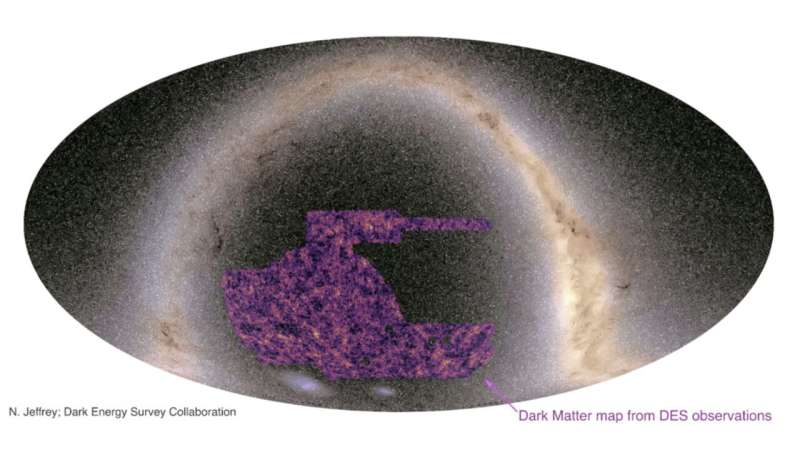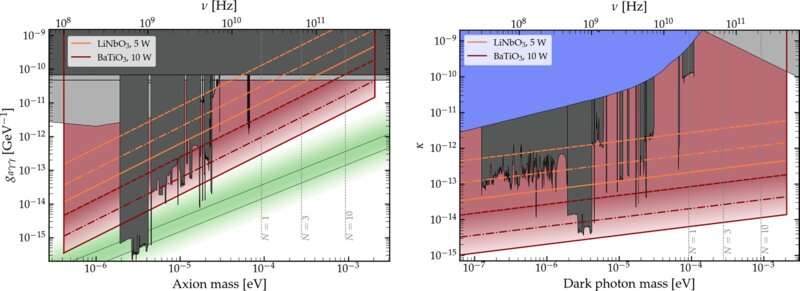March 15, 2024 feature
This article has been reviewed according to Science X's editorial process and policies. Editors have highlighted the following attributes while ensuring the content's credibility:
fact-checked
peer-reviewed publication
trusted source
proofread
GALILEO: Scientists propose a new method to search for light dark matter

New research in Physical Review Letters (PRL) has proposed a novel method to detect light dark matter candidates using laser interferometry to measure the oscillatory electric fields generated by these candidates.
Dark matter is one of the most pressing challenges in modern physics, with dark matter particles being elusive and hard to detect. This has prompted scientists to come up with new and innovative ways to look for these particles.
There are several candidates for dark matter particles, such as WIMPs, light dark matter particles (axions), and the hypothetical gravitino. Light dark matter, including bosonic particles like the QCD (quantum chromo dynamics) axion, has become a point of interest in recent years.
These particles typically have suppressed interactions with the standard model, making them challenging to detect. However, knowing their characteristics, including their wave-like behavior and coherent nature at galactic scales, helps to design more efficient experiments.
In the new PRL study, researchers from the University of Maryland and Johns Hopkins University have proposed Galactic Axion Laser Interferometer Leveraging Electro-Optics or GALILEO, a new approach to detect both axion and dark photon dark matter over a wide mass range.
Lead researcher Reza Ebadi, a graduate student at the Quantum Technology Center (QTC) at the University of Maryland, spoke to Phys.org about the research and their motivation for developing this new approach, "Although the standard model provides successful explanations of phenomena ranging from sub-nuclear distances to the size of the universe, it is not a complete explanation of nature."
"It fails to account for cosmological observations from which the existence of dark matter is inferred. We aspire to gain insight into the physical theories operating on galactic scales using small-scale lab experiments."
Axions and axionlike particles
Axions and axionlike particles were initially proposed to solve problems in particle physics, such as the strong charge-parity (CP) problem. This problem arises from the observation that the strong force doesn't seem to exhibit a particular type of symmetry violation, called CP violation, as much as theory predicts it should.
This theoretical framework naturally gives rise to axionlike particles, which share similar properties to axions, with both being bosons.
Axions and axionlike particles are predicted to have very low masses, typically ranging from microelectronvolts to millielectronvolts. This makes them suitable candidates for light dark matter, as they can exhibit wave-like behavior at galactic scales.
In addition to their low mass, axions and axionlike particles interact very weakly with ordinary matter, making them difficult to detect using conventional means.
These are some reasons the researchers have chosen to detect these particles in their experimental setup. However, the method hinges on oscillatory electric fields produced by these particles.
In regions with significant dark matter density, axions and ALPs can undergo coherent oscillations. These coherent oscillations can give rise to detectable signals, such as oscillatory electric fields, which the proposed GALILEO experiment aims to measure.

GALILEO
"Light dark matter candidates behave as waves in the solar neighborhood. Such dark matter waves are predicted to induce very weak oscillating electric fields with magnetic fields because of their minuscule interactions with electromagnetism."
"We focused on the detection of the electric field rather than the magnetic field, which is the target signal in most current and proposed experiments," explained Ebadi.
Light dark matter-induced electric fields can be detected using electro-optical materials, where the external electric field modifies the material's properties, such as refractive index.
GALILEO utilizes an asymmetric Michelson interferometer, a device that can measure the changes in refractive index. One arm of the interferometer contains the electro-optical material.
When a probe laser beam is split and sent through the two arms of the interferometer, the arm containing the electro-optical material introduces a variable refractive index. This change in refractive index affects the phase of the laser beam, resulting in an oscillating signal when the beams are merged back together.
By measuring the differential phase velocity between the two arms of the interferometer, GALILEO can detect the frequency of oscillation induced by light dark matter. This oscillatory signal serves as the signature of the presence of dark matter particles.
The sensitivity of the method can be increased by incorporating Fabry-Perot cavities (which increase the length of the interferometer arm, allowing for greater precision) and taking repeated independent measurements.
Laser interferometry and implementing GALILEO
The research relies on precision measurements by laser interferometry.
Ebadi explained, "A prime example of how laser interferometers can be used for precision measurements is LIGO, the ground-based gravitational wave detector."
"Our proposal uses similar technological advancements as LIGO, such as Fabry-Perot cavities or squeezed light to suppress the quantum noise limit. However, unlike LIGO, the proposed GALILEO interferometer is a tabletop-scale device."
Even though the work is theoretical, the researchers already have plans to implement the experimental program step-by-step.
Importantly, they want to determine the technical parameters required for an optimized experimental setup, which they plan to use for conducting scientific experiments to search for light dark matter.
Additionally, Ebadi highlights the importance of operating high-finesse Fabry-Perot cavities alongside electro-optical material within the cavity, as well as characterizing the noise budget and setup systematics, which are crucial aspects of the experimental process.
"GALILEO has the potential to be a significant component of the bigger mission of exploring the vast theoretically viable space of dark matter candidates," concluded Ebadi.
More information: Reza Ebadi et al, GALILEO: Galactic Axion Laser Interferometer Leveraging Electro-Optics, Physical Review Letters (2024). DOI: 10.1103/PhysRevLett.132.101001.
Journal information: Physical Review Letters
© 2024 Science X Network




















